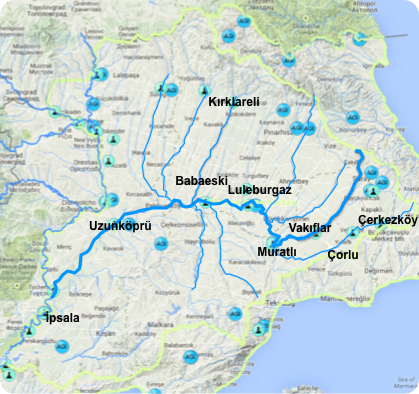Current
The pandemic has changed our hygiene habits along with our daily life. The aim of this project is to systematically show that quaternary ammonium compounds (QAC), which are the active components of most disinfectants used in the control of SARS-CoV-2, increase the genome plasticity of bacteria and reduce the effectiveness of these chemicals and many antibiotics.
Scientific and Technological Research Council of Turkey (TUBITAK)
Monitoring the presence and biodegradation potential of organic disinfectants in Turkish rivers during the one-year SARS-CoV2 pandemic (2022-…)
The aim of this project is to determine the change in the concentration of BACs during pandemic with seasonal water samples from five rivers located in three different regions.
Boğaziçi University Scientific Research Projects Fund under grant 22Y00P2
Water resource contamination substantially threatens the environment. Rapid identification of chemicals and their emission sources in watersheds is crucial for sustainable water resources management. Despite studies on the measurement of micropollutants in the water resources around Europe, efficient utilization of the data in decision-making to protect water resources from detrimental chemical pollution is currently not available. Novel Internet of Things (IoT) technologies, coupled with advanced Artificial Intelligence (AI) strategies, may provide faster and more efficient responses to these challenges in real-time reactions as well as long-term planning, for more information.
CHIST-ERA grant CHIST-ERA-19-CES-005, by the Austrian Science Fund (FWF), by the Swiss National Science Foundation (SNSF), by the Academy of Finland (AKA), and by the Scientific and Technological Research Council of Turkey (TUBITAK)
Previous
Determination of Mobile Genetic Element of OxyBAC Gene Cluster and Its Ecophylogenetic Analysis (P.I.: Ulas Tezel, 2019-2020)
Biodegradable disinfectant chemicals are safe for the environment but pose a risk to human health. Quaternary ammonium compounds (DABs) are a group of chemicals from biodegradable disinfectant active ingredients that are widely consumed for cleaning in domestic, industrial and clinical settings all over the world. Among DABs, benzalkonium chlorides (BACs) are the most popular group of active ingredients. The web application we prepared as a result of the project is online and continues to process.
Boğaziçi University Scientific Research Projects Fund under grant 20Y00P5
The aim of this project is to sequence the entire genome of BIOMIG1, to make sense of it and to extract the metabolic network of the bacterium. For this purpose, reads obtained from Illumina and Nanopore platforms were hybridized. As a result, the circular chromosome and existing plasmids of BIOMIG1 were determined and their gene contents were determined and published.
Boğaziçi University Scientific Research Projects Fund under grant 19Y00P4
Development of a geographical information systems based decision-making tool for water quality management of Ergene watershed using pollutant fingerprints (P.I.: Ulas Tezel, 2015-2018)
The Scientific and Technological Research Council of Turkey
Biotransformation Potential and Pathways of Antibiotics by Pseudomonas sp. BIOMIG1 (P.I.: Ulas Tezel, 2014)
Boğaziçi University Scientific Research Projects Fund under grant 14Y00M9
Development of enzyme bioreactors for the advanced treatment of wastewater containing antimicrobial chemicals (P.I.: Ulas Tezel, 2014-2017)
The Scientific and Technological Research Council of Turkey
On The Track of the “Super Bug”: Microbial Ecology and Genetics of Disinfectant Biotransformation (P.I.: Ulas Tezel, 2013)
Boğaziçi University Scientific Research Projects Fund under grant 7130M
European Research Council FP7-PEOPLE-Marie Curie-Career Integration Grant








